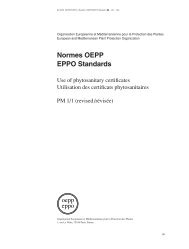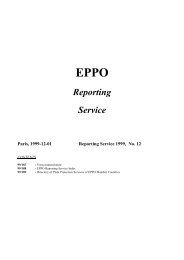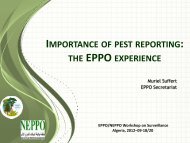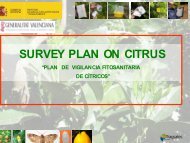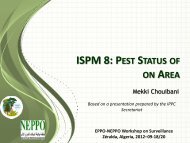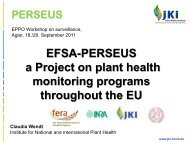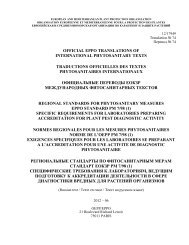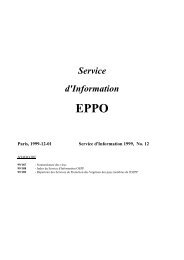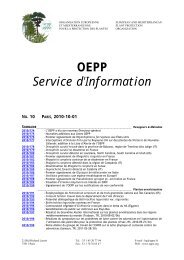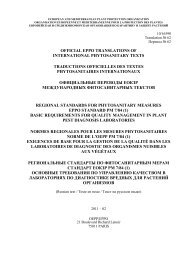EPPO Reporting Service - Lists of EPPO Standards - European and ...
EPPO Reporting Service - Lists of EPPO Standards - European and ...
EPPO Reporting Service - Lists of EPPO Standards - European and ...
Create successful ePaper yourself
Turn your PDF publications into a flip-book with our unique Google optimized e-Paper software.
<strong>EPPO</strong> <strong>Reporting</strong> <strong>Service</strong> – Invasive Plants<br />
vigorously in flowing water. In Florida, the species has been reported as able to exp<strong>and</strong><br />
from 0.04 ha to 0.41 ha in one year.<br />
In which habitats<br />
In warmer climates, H. polysperma prefers flowing streams, but it may also be found in<br />
slow-moving waters <strong>and</strong> in lakes. According to the Corine L<strong>and</strong> Cover nomenclature, the<br />
following habitats are invaded: continental waters (water courses, water bodies), banks <strong>of</strong><br />
continental water, Riverbanks/canalsides (dry river beds).<br />
Pathways<br />
Within the <strong>EPPO</strong> region, H. polysperma is imported for aquarium purposes in large<br />
quantities into various countries such as Austria, Estonia, France, Hungary, Latvia, the<br />
Netherl<strong>and</strong>s <strong>and</strong> Switzerl<strong>and</strong>. H. polysperma fragments very easily (vegetative<br />
reproduction), <strong>and</strong> these plant fragments can be spread by boats or wildlife.<br />
Impacts<br />
H. polysperma can out-shade other submersed plants, <strong>and</strong> is even reported to out-compete<br />
the very invasive Hydrilla verticillata (<strong>EPPO</strong> Alert List), as well as Ludwigia repens. It can<br />
occupy the entire water column <strong>and</strong> restricts light to other species, displacing native flora<br />
<strong>and</strong> fauna, <strong>and</strong> disrupting the aquatic ecosystem balance. Additionally, when large st<strong>and</strong>s<br />
<strong>of</strong> H. polysperma die, their decomposition can create anoxic conditions resulting in fish<br />
death. Mats formed by the plant may also provide suitable breeding grounds for<br />
mosquitoes. H. polysperma clogs irrigation <strong>and</strong> flood-control canals, <strong>and</strong> interferes with<br />
water control pumping stations. It is also detrimental to navigation <strong>and</strong> recreational<br />
activities such as fishing <strong>and</strong> swimming.<br />
Control<br />
The species is considered to be difficult to control, even more so than Hydrilla verticillata.<br />
The use <strong>of</strong> mechanical harvesters further fragments the plant <strong>and</strong> favours its spread.<br />
Registered aquatic herbicides only marginally control H. polysperma. Endothal is the only<br />
active substance mentioned in the literature as having some efficacy against the plant.<br />
In the USA, this species is listed at the federal level as a noxious weed, <strong>and</strong> is regulated in<br />
many States.<br />
Considering the invasive behaviour <strong>of</strong> this species elsewhere in the world, it is considered<br />
that flowing freshwater bodies <strong>of</strong> the Mediterranean <strong>and</strong> temperate countries are at risk,<br />
<strong>and</strong> that the species should usefully be monitored, particularly in countries currently<br />
importing this species as an aquarium plant. H. polysperma is therefore added to the Alert<br />
List.<br />
Source: Commonwealth <strong>of</strong> Massachussets, Department <strong>of</strong> Conservation <strong>and</strong> Recreation<br />
(Undated) Eastern Indian Hygrophila: an exotic aquatic plant. 3 pp.<br />
http://www.mass.gov/dcr/waterSupply/lakepond/factsheet/Hygrophila.pdf<br />
Doyle RD, Francis MD, Smart RM (2003) Interferente competition between Ludwigia<br />
repens <strong>and</strong> Hygrophila polysperma: two morphologically similar aquatic plant<br />
species. Aquatic Botany 77, 223-234.<br />
Florida Exotic Pest Plant Council (Undated) Hygrophila polysperma.<br />
http://www.fleppc.org/ID_book/Hygrophila%20polysperma.pdf<br />
Global invasive species database (2009) Hygrophila polysperma.<br />
http://www.issg.org/database/species/ecology.asp?si=759&fr=1&sts=&lang=EN<br />
Mora-Olivo A, Daniel TF, Martínez M (2008) Hygrophila polysperma (Acanthaceae),<br />
una maleza aquática registrada por primera vez para la flora mexicana. Revista<br />
Mexicana de Biodiversidad 79, 265-269.<br />
http://www.ejournal.unam.mx/bio/BIOD79-01/BIO079000121.pdf<br />
24




